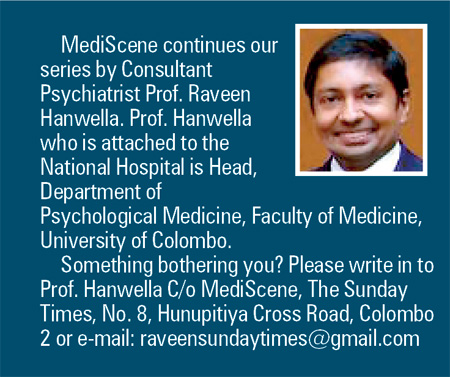The Big Four that make you feel more than low
I read The Big Four, a work of fiction by Agatha Christie, as a schoolboy. It features Christie’s legendary detective Hercule Poirot but cast in a different role in a tale of international intrigue and espionage. In the novel, the big four are masterminds who control an international criminal cartel. The big four I am referring to are different but nevertheless have the potential to cause serious harm to society.
Depressive disorder, schizophrenia, bipolar disorder and dementia, the big four I am going to talk about are the four main psychiatric disorders that affect human beings.

Women are twice as likely to be affected as men by depressive disorder . Pic courtesy REUTERS
Depressive disorder
Here I am not referring to depression, a common emotion affecting humans but a serious psychiatric disorder. Depressive disorder is not just a passing feeling of sadness but rather persistent feelings of sadness and worthlessness and a lack of desire to engage in formerly pleasurable activities. It is the commonest of the major psychiatric disorders and affects nearly seven percent of adults in a given year.
There is no single cause for depressive disorder. Rather, it likely results from a combination of genetic, biochemical, environmental, and psychological factors. Women are twice as likely to be affected as men and biological, life cycle, hormonal, and other factors unique to women may be linked to their higher depression rate.
Some women are susceptible to a severe form of premenstrual syndrome called premenstrual dysphoric disorder or PMDD. Those affected typically experience depression, anxiety, irritability and mood swings the week before menstruation. Women with PMDD do not have unusual hormone changes but respond differently to these changes. Some women are vulnerable to depression after giving birth. Many new mothers experience a brief episode of low mood and irritability called maternal blues. They recover without any specific treatment but others go on to develop postpartum depression, a more serious condition that requires quick and active treatment.
Severe depressive disorder increases the risk of suicide and men are more likely to die of suicide than women though more women attempt suicide. Depressive disorder in the elderly is easily missed as they are less likely to experience or express feelings of sadness or grief. They show more behavioural symptoms such as withdrawal from social interaction, irritability or physical symptoms like lethargy, loss of appetite and difficulty sleeping. The elderly are more likely to have physical conditions such as heart disease, stroke or diabetes, the symptoms of which can be similar to depression. Physicians may treat the physical component but fail to look for or treat the underlying or coexisting depressive disorder.

Depressive disorder is a highly treatable disorder and as with the other big three, the earlier treatment begins, the more effective it is and greater the likelihood of preventing relapses. The mainstay of treatment of depressive disorder is antidepressants. A wide range of antidepressants with different mechanisms of action is now available. The psychiatrist will decide on the best antidepressant depending on the severity of illness, concomitant physical illnesses and medications and past response to treatment. It is now clear that an individual patient’s response depends on his or her genetic profile but at this moment in time, it is not possible to decide on the best antidepressant by genetic testing. But that day is not far off. Less severe forms of depressive disorder could be treated with psychotherapy and cognitive therapy and interpersonal therapy are two such therapies that are effective for this condition. However, finding a therapist with competence in such therapies might be a problem.
A person with depressive disorder if treated early and effectively can hope to return to normal functioning in four to six months’ time. It is important that the patient take medication for the full length of time prescribed by the psychiatrist. Medicines are usually prescribed for about two months after full resolution of symptoms. This is because research has shown that if antidepressants are stopped early the risk of a relapse is very high. If a person has had several episodes of depressive disorder, the psychiatrist may recommend that antidepressants be continued indefinitely. Though patients may be reluctant to follow this advice nevertheless, it is sound advice since there is good evidence that the chance of a relapse is increased after each episode reaching 90 percent after three relapses. Also, there is now evidence from scans of the brain that repeated depressive episodes cause permanent damage to the brain and increase resistance to treatment.
Schizophrenia
This is the next of the big four. The term schizophrenia which translates from the Greek as ‘splitting of the mind’ was coined by the Swiss psychiatrist Eugene Bleuler in 1908. It describes the separation of function between thinking, memory and perception that occurs in the disease and does not mean a split personality as commonly thought.
The main symptoms of schizophrenia include false beliefs not based on evidence (delusions), hearing voices when there is no one around (auditory hallucinations), disorganised thinking and speech (thought disorder), and loss of contact with reality. These symptoms found mostly in the initial stages of the disease are called positive symptoms. After the acute stage, some patients are left with a group of symptoms known as negative symptoms. They include poor expression of emotions, reduced speech, lack of desire to form relationships and lack of motivation. These symptoms are more resistant to treatment than positive symptoms and contribute to poor quality of life and functional ability.
The causes are genetic and environmental and the prevalence of the disease is constant throughout the world. Though structural changes in the brain have been demonstrated, as yet there are no laboratory, neuroimaging or genetic tests to identify the disease. Diagnosis is based on careful history and mental state examination by an experienced psychiatrist.
The first line of treatment for schizophrenia is antipsychotic medication. The first such antipsychotic chlorpromazine also known as largactil discovered in 1950 revolutionised psychiatric treatment and enabled a large number of patients with schizophrenia to be discharged into the community from long stay institutions. We now have a wide range of antipsychotics available. As with depressive disorder, it is important to diagnose and treat schizophrenia early. There is strong evidence that delay in treatment causes permanent brain damage and reduces the chance of full recovery. Schizophrenia too is a relapsing illness and some patients need to continue medication for life to prevent relapses. Persons who are left with negative symptoms after initial treatment with antipsychotics benefit from psychosocial rehabilitation,
The take home message: If you or a relative has depressive disorder or schizophrenia treat early and continue until told to stop by the psychiatrist.
Next month: The other big two, bipolar disorder and dementia.


